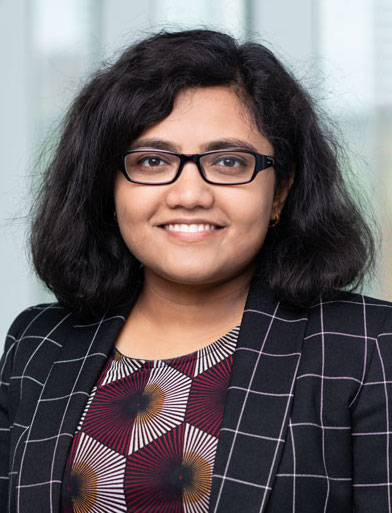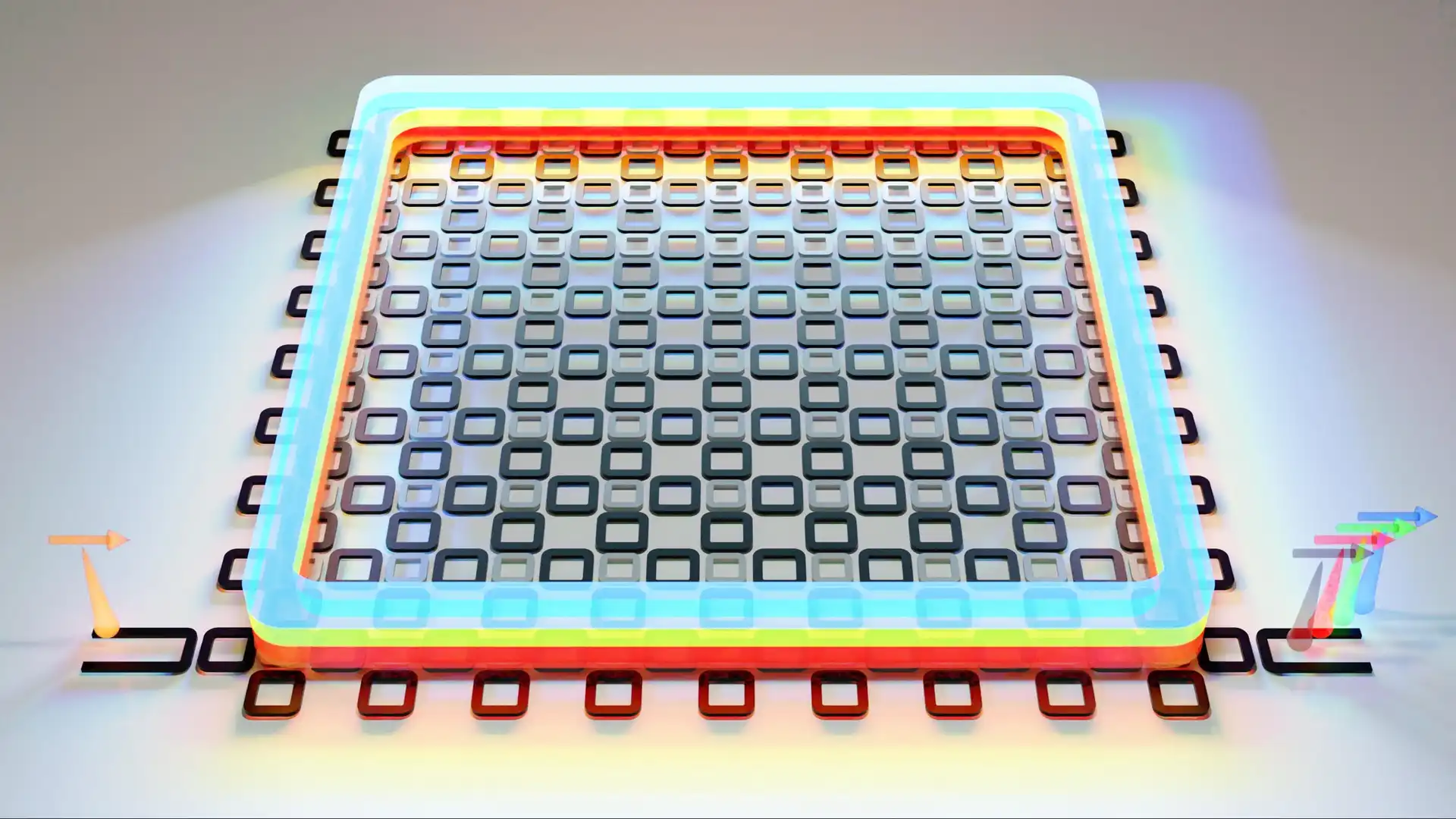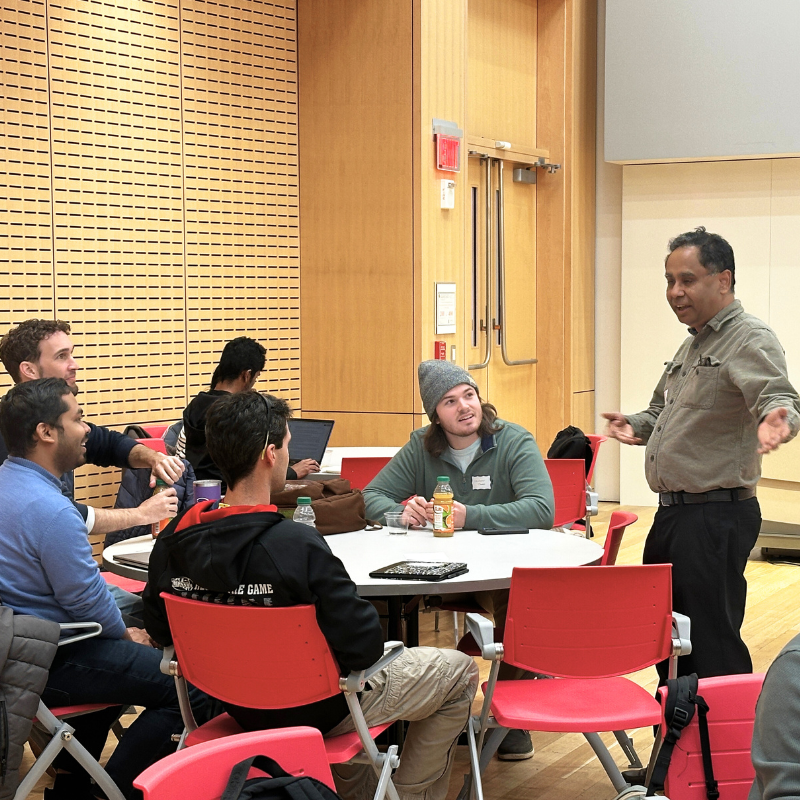News Story
Booz Allen Colloquium Series to Explore Wide Range of Topics

The Spring 2011 Booz Allen Colloquium series will kick off with a talk by ECE alumnus Prof. Dennis Prather (B.S. '89, M.S. '93, Ph.D. '97) of the University of Delaware who will speak about an imaging system using millimeter waves (mmWs) that allows for the ability to see through obscurants, such as blowing sand, fog, dust, smoke, and light rain. The series will close with a talk by Prof. Robert Olberg of Union College who will offer an analysis of the interception flights of dragonflies, and describe a group of neurons that help direct the flight.
The Booz Allen Hamilton Distinguished Colloquium Series in ECE features distinguished speakers from across the nation and around the globe, and also provides venues in which ECE faculty at the University of Maryland can showcase their research to a broad audience of their colleagues and students, as well as friends of the university. The Distinguished Colloquium Series is sponsored by Booz Allen Hamilton.
The following offers a brief overview of each of the eight speakers and their talks this spring:
 February 18, 2011
February 18, 2011
Millimeter Wave Imaging: Seeing Beyond the Dark
Prof. Dennis Prather, Department of Electrical and Computer Engineering,
University of Delaware & Commander, USN (RC)
Jeong H. Kim Engineering Building, Rm. 1110
3:00 p.m.
Prof. Dennis Prather (B.S. '89, M.S. '93, Ph.D. '97) of the University of Delaware who will speak about an imaging system using millimeter waves (mmWs) that allows for the ability to see through obscurants, such as blowing sand, fog, dust, smoke, and light rain. It also offers the ability to see through certain types of materials, like outer garments, fiberglass, drywall, and others. In the course of this talk, Dr. Prather will discuss some of the unique attributes of mmWs and some of the underlying technologies used to capture and process these signals into images. Dennis Prather is Professor of Electrical and Computer Engineering at the University of Delaware (UD) and a Naval Reserve Officer. He earned his Ph.D. in Computational Electromagnetics at the University of Maryland. At UD he leads the Nano-Photonics research group, specializing in the development of computational EM models and nano-fabrication processes for photonic devices.
 February 25, 2011
February 25, 2011
Compressive Sensing: A Potentially Revolutionary Technology
Prof. H.T. Kung, William H. Gates Professor of Computer Science and Electrical Engineering, Harvard University
Jeong H. Kim Engineering Building, Rm. 1110
3:00 p.m.
In this presentation, Prof. Kung will examine issues related to transition of compressive sensing technology to the applied research world. He will introduce the basic concepts of compressed sensing, and argue that potential applications can be beyond signal processing to include cognitive radio, hardware intrusion detection, resource management in cloud computing, etc. In addition, he will describe recent research aimed at making the technology resilient against sensing errors or malicious attacks. Prof. H. T. Kung is William H. Gates Professor of Computer Science and Electrical Engineering at Harvard University. He has pursued a variety of research interests in his career, including complexity theory, database systems, VLSI design, parallel computing, computer networks, network security, wireless communications, and networking of unmanned aerial systems. Professor Kung's professional honors include selection as a Member of the National Academy of Engineering, a Member of the Academia Sinica (in Taiwan), and the recipient of a Guggenheim Fellowship.
 March 7, 2011
March 7, 2011
Control and Computing in Cyber-Physical Systems
Prof. Marilyn Wolf, Rhesa "Ray" S. Farmer, Jr., Distinguished Chair in Embedded Computing Systems; Georgia Research Alliance Eminent Scholar, Georgia Tech
Jeong H. Kim Engineering Building, Rm. 1110
5:00 p.m.
(Please note special day and time - 5:00pm, Mon., March 7)
Prof. Wolf will discuss cyber-physical systems, a new area whose goal is a fundamental understanding of the relationship between control and computation. We know surprisingly little about control/computing co-design despite 60 years of designing control systems using computing. Prof. Wolf will discuss two aspects of cyber-physical system design, including how to design a battery-powered control system in a way that minimizes the effect of the battery's time-dependent behavior. Marilyn Wolf is Farmer Distinguished Chair and Georgia Research Alliance Eminent Scholar at the Georgia Institute of Technology. She received her BS, MS, and PhD in electrical engineering from Stanford University in 1980, 1981, and 1984, respectively. She was with AT&T Bell Laboratories from 1984 to 1989. She was on the faculty of Princeton University from 1989 to 2007. Her research interests included embedded computing, embedded video and computer vision, and VLSI systems. She has received the ASEE Terman Award and IEEE Circuits and Systems Society Education Award. She is a Fellow of the IEEE and ACM and an IEEE Computer Society Golden Core member.
 March 11, 2011
March 11, 2011
The Era of Heterogeneous Compute
Prof. Sudhakar Yalamanchili, Electrical and Computer Engineering,
Georgia Tech
Jeong H. Kim Engineering Building, Rm. 1110
3:00 p.m.
The transition to many core computing and the dominant role of energy, power and thermal limits to computation is leading to asymmetry, heterogeneity, and technology diversity being leading drivers for the design of future many core architectures seeking major improvements in throughput and joules/operation. Prof. Yalamanchili's talk will offer a view of this evolution and the resulting challenges to system software. Prof. Yalamanchili joined the ECE faculty at Georgia Tech in 1989 where he is now a Joseph M. Pettit Professor of Computer Engineering. He is the author of VHDL Starters Guide, 2nd edition, Prentice Hall 2004, VHDL: From Simulation to Synthesis, Prentice Hall, 2000, and co-author with J. Duato and L. Ni, of Interconnection Networks: An Engineering Approach, Morgan Kaufman, 2003. His current research foci lie in addressing the software challenges of heterogeneous architectures and solutions to power and thermal issues in many core architectures and data centers.
 March 17, 2011
March 17, 2011
Wavelets on Graphs: Theory and Applications
Prof. Antonio Ortega, Signal and Image Processing Institute, Department of Electrical and Computer Engineering, University of Southern California
CSIC Lecture Hall, Rm. 1115
5:00 p.m.
(Please note special day - Thursday, March 17)
Wavelet transforms have become popular tools for numerous signal processing tasks, from compression to analysis or denoising. These transforms provide a class of signal representations with flexible time (or space) and frequency localization. In this presentation Prof. Ortega will focus on wavelet-like, multiresolution transforms for datasets that are defined on arbitrary graphs. He will then provide an overview of two potential applications of these transforms in i) distributed data gathering in a sensor network and ii) image compression. In 1994, Prof. Ortega joined the Electrical Engineering department at the University of Southern California (USC), where he is currently a Professor and Associate Chair of EE-Systems. He has served as director of the Signal and Image Processing Institute at USC. He is a Fellow of the IEEE, and a member of ACM. His research interests are in the areas of multimedia compression, communications and signal analysis. His recent work is focusing on distributed compression, multiview coding, error tolerant compression, wavelet-based signal analysis and information representation in wireless sensor networks.
 April 8, 2011
April 8, 2011
NOAA's Environmental Satellites
Ajay Mehta, Deputy Director, Office of Satellite and Product Operations,
National Oceanic and Atmospheric Administration (NOAA)
Jeong H. Kim Engineering Building, Rm. 1110
3:00 p.m.
Satellites operated by the National Oceanic and Atmospheric Administration (NOAA), along with satellites operated by the National Aeronautics and Space Administration (NASA), the Department of Defense, and foreign partners are an essential part of our society. Data from these satellites comprise 99% of the observations used in numerical weather prediction models and are an indispensable tool allowing NOAA's National Weather Service to accomplish its mission of providing forecasts and warnings for the protection of life and property and the enhancement of the national economy. Along with providing critical environmental data, NOAA’s satellites provide other services such as detecting and locating distress signals from anywhere on the globe and providing situational awareness to emergency managers in the field. Ajay Mehta is the Deputy Director of NOAA's Office of Satellite and Product Operations. In this capacity he is responsible for overseeing the day-to-day operations of NOAA and USAF environmental satellites and associated data processing and delivery of environmental products to the National Weather Service and other domestic and international users. Mr. Mehta serves as the U.S. Representative to the Cospas-Search and Rescue Satellite-Aided Tracking (SARSAT) Council overseeing the international satellite-aided search and rescue program.
 April 15, 2011
April 15, 2011
Controlled Interactions Between Quantum Dots and Light Using Photonic Crystals
Prof. Edo Waks, Department of Electrical and Computer Engineering,
University of Maryland
Jeong H. Kim Engineering Building, Rm. 1110
3:00 p.m.
Quantum dots (QDs) are stable, bright, semiconductor based light emitters that exhibit a quantized energy spectrum. For these reasons they are excellent candidates for development of lasers, nonlinear optoelectronic components, and basic building blocks for future quantum information technology. Such applications critically depend on the ability to create strong interactions between QDs and photon fields. One method to engineer these strong interactions is to use photonic crystal structures. Photonic crystals are materials with a periodic index of refraction that can guide and confine light on the size scale of an optical wavelength, resulting in extremely strong atom-photon interactions. In this talk, Prof. Waks will discuss recent work on interactions between quantum dots and photonic crystals. He will describe how such interactions can lead to ultra low-power all-optical switching, and how this switching can be extended to implement quantum computation on a semiconductor chip. Edo Waks is a professor in the Department of Electrical and Computer Engineering at the University of Maryland. He is also a member of the Joint Quantum Institute (JQI), a collaborative effort between the University of Maryland and NIST, Gaithersburg, dedicated to the study of quantum coherence. He is a recipient of an NSF CAREER award as well as a Presidential Early Career Award for Scientists and Engineers (PECASE) for the investigation of interactions between quantum dots and nanophotonic structures.

April 29, 2010
Neurons and Behavior: The Visual Control of Prey Interception Flights in the Dragonfly
Prof. Robert Olberg, Biology Department, Union College
Jeong H. Kim Engineering Building, Rm. 1110
3:00 p.m.
Dragonflies make their living by capturing small insects in flight. To accomplish this task, the perched dragonfly calculates a take-off direction that leads the flying insect and performs flight corrections to maintain an interception trajectory. In this talk, Prof. Olberg will present high-speed video analysis of the interception flights and describe a group of neurons that are implicated in directing the flight. The goal of this research is to better understand the way in which a nervous system controls orientation and interaction with moving objects. Robert Olberg is the Florence B. Sherwood Professor of Life Sciences at Union College in Schenectady, New York. Dr. Olberg has worked with his undergraduate research students on the sensory systems of a variety of insects, but most notably the visual control of flight in dragonflies, with studies in his lab ranging from analysis of single neuron activity to flight behavior. His work has been funded by the National Science Foundation, Research Corporation, U.S. Department of Agriculture, Air Force Office of Scientific Research, and Howard Hughes Medical Institute.
Colloquium talks can be viewed online here
Published February 7, 2011









